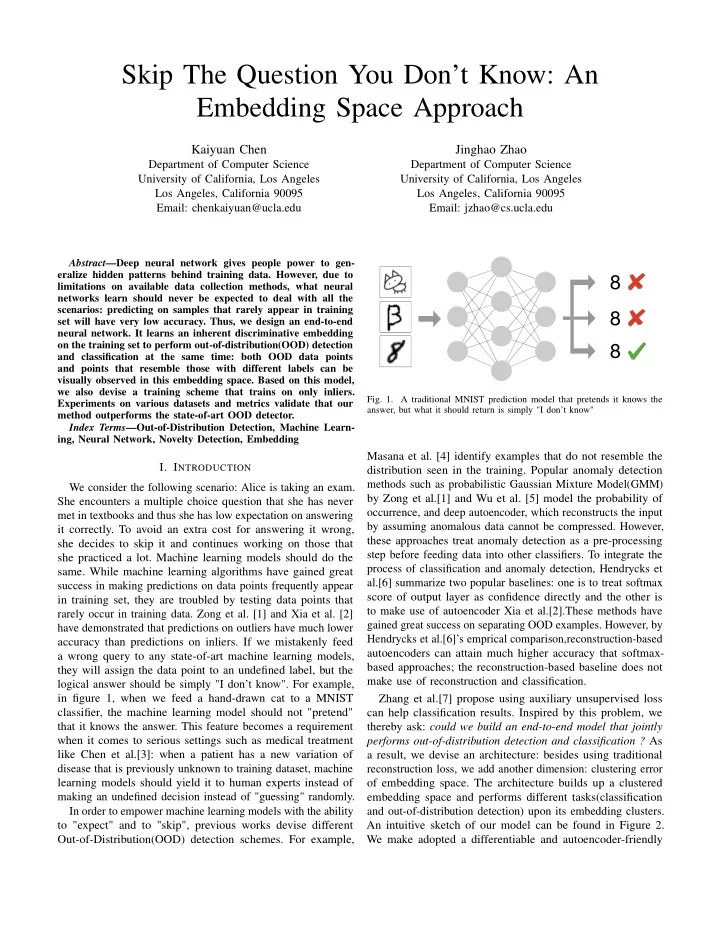

Skip The Question You Don’t Know: An Embedding Space Approach Kaiyuan Chen Jinghao Zhao Department of Computer Science Department of Computer Science University of California, Los Angeles University of California, Los Angeles Los Angeles, California 90095 Los Angeles, California 90095 Email: chenkaiyuan@ucla.edu Email: jzhao@cs.ucla.edu Abstract —Deep neural network gives people power to gen- 8 eralize hidden patterns behind training data. However, due to limitations on available data collection methods, what neural networks learn should never be expected to deal with all the scenarios: predicting on samples that rarely appear in training 8 set will have very low accuracy. Thus, we design an end-to-end neural network. It learns an inherent discriminative embedding 8 on the training set to perform out-of-distribution(OOD) detection and classification at the same time: both OOD data points and points that resemble those with different labels can be visually observed in this embedding space. Based on this model, we also devise a training scheme that trains on only inliers. Fig. 1. A traditional MNIST prediction model that pretends it knows the Experiments on various datasets and metrics validate that our answer, but what it should return is simply "I don’t know" method outperforms the state-of-art OOD detector. Index Terms —Out-of-Distribution Detection, Machine Learn- ing, Neural Network, Novelty Detection, Embedding Masana et al. [ 4 ] identify examples that do not resemble the I. I NTRODUCTION distribution seen in the training. Popular anomaly detection methods such as probabilistic Gaussian Mixture Model(GMM) We consider the following scenario: Alice is taking an exam. by Zong et al.[ 1 ] and Wu et al. [ 5 ] model the probability of She encounters a multiple choice question that she has never occurrence, and deep autoencoder, which reconstructs the input met in textbooks and thus she has low expectation on answering by assuming anomalous data cannot be compressed. However, it correctly. To avoid an extra cost for answering it wrong, these approaches treat anomaly detection as a pre-processing she decides to skip it and continues working on those that step before feeding data into other classifiers. To integrate the she practiced a lot. Machine learning models should do the process of classification and anomaly detection, Hendrycks et same. While machine learning algorithms have gained great al.[ 6 ] summarize two popular baselines: one is to treat softmax success in making predictions on data points frequently appear score of output layer as confidence directly and the other is in training set, they are troubled by testing data points that to make use of autoencoder Xia et al.[ 2 ].These methods have rarely occur in training data. Zong et al. [ 1 ] and Xia et al. [ 2 ] gained great success on separating OOD examples. However, by have demonstrated that predictions on outliers have much lower Hendrycks et al.[ 6 ]’s emprical comparison,reconstruction-based accuracy than predictions on inliers. If we mistakenly feed autoencoders can attain much higher accuracy that softmax- a wrong query to any state-of-art machine learning models, based approaches; the reconstruction-based baseline does not they will assign the data point to an undefined label, but the make use of reconstruction and classification. logical answer should be simply "I don’t know". For example, in figure 1, when we feed a hand-drawn cat to a MNIST Zhang et al.[ 7 ] propose using auxiliary unsupervised loss classifier, the machine learning model should not "pretend" can help classification results. Inspired by this problem, we that it knows the answer. This feature becomes a requirement thereby ask: could we build an end-to-end model that jointly when it comes to serious settings such as medical treatment performs out-of-distribution detection and classification ? As like Chen et al.[ 3 ]: when a patient has a new variation of a result, we devise an architecture: besides using traditional disease that is previously unknown to training dataset, machine reconstruction loss, we add another dimension: clustering error learning models should yield it to human experts instead of of embedding space. The architecture builds up a clustered making an undefined decision instead of "guessing" randomly. embedding space and performs different tasks(classification In order to empower machine learning models with the ability and out-of-distribution detection) upon its embedding clusters. to "expect" and to "skip", previous works devise different An intuitive sketch of our model can be found in Figure 2. Out-of-Distribution(OOD) detection schemes. For example, We make adopted a differentiable and autoencoder-friendly
Recommend
More recommend